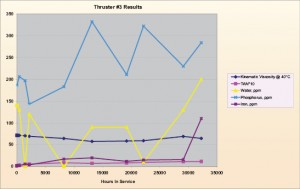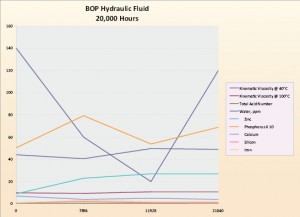Environmental benefits may outweigh higher initial costs for readily biodegradable lubricants
By Mark Miller, Terresolve Technologies
Diamond Offshore Drilling has worked with Ohio-based Terresolve Technologies to replace the petroleum lubricants used on Diamond’s rigs with readily biodegradable fluids where feasible.
Petroleum-based lubricants were quickly ruled out. These lubricants may be “inherently biodegradable,” yet they persist in the environment for years and require long-term remediation. “Inherently biodegradable” simply means that the product “has the propensity to biodegrade,” and no specific time frame or degree are given for the breakdown.

Consequently, only “readily (rapidly) biodegradable” fluids, which break down quickly when they enter the environment, were considered.
These types of biodegradable fluids were considered:
• Conventional vegetable-based fluids: These fluids are readily biodegradable, but, when exposed to heat, begin to break down to the point of destruction. Specifically, when biodegradable oils are blended with vegetable oils, the resulting vegetable-based fluids can only withstand operating temperatures under 160°F. As a result, vegetable-based fluids have a limited life expectancy under heat exposure. Vegetable-based fluids also become unstable when exposed to water or moist environments.
Vegetable-based fluids generally perform well within their working parameters, but an equipment operator must take care to ensure that such parameter boundaries are not violated. Therefore, it was determined that vegetable-based fluids were not the best choice because Diamond Offshore’s drilling equipment is frequently used in moisture-oriented climates and the fluids will likely be exposed to high temperatures.
• Synthetic esters: These are also readily biodegradable. They hold up well in oxidation tests, which determine the life of the lubricant in dry operating environments. However, synthetic esters become unstable when subjected to moisture, and this instability contributes to acid formation. Moreover, synthetic esters cause rapid degradation of rubber seals/hoses and may break down when exposed to heat. This lubricant type was considered not appropriate for Diamond due to the climate in which its rigs operate and the high temperatures to which its equipment is exposed.
Polyalkylene Glycol (PAG): PAG can be biodegradable but is also found in non-biodegradable form. It is intolerant to both conventional petroleum oils and vegetable oils. PAG is very soluble, which can lead to corrosion and rust within a hydraulic system if exposed to water. Moreover, PAG is typically incompatible with seals and filters customarily used in the marine equipment. Accordingly, a rig operator would be required to change to compatible seals, hoses and filters prior to using PAG. This lubricant type was also not considered the appropriate type of lubricant for Diamond.
• Biopolyolefin synthetic biodegradable (Biopolyolefin): This lubricant offers stable performance in all temperature ranges, climates and seal compatibilities. It is readily biodegradable, non-toxic and tolerant of water and contaminants. In addition, it is compatible with conventional petroleum and most other biodegradable products. This lubricant was accepted as the readily biodegradable fluid for Diamond.
IMPLEMENTATION
Following the fluids analysis, Diamond was provided with a readily biodegradable synthetic hydraulic fluid, EnviroLogic 3046, or EL 3046. One advantage to using this fluid is that it has already received approval by component manufacturers. Also, the product does not create “rainbow sheen” on the water in the event of a leak.
This hydraulic fluid was implemented into the jacking systems of several Diamond jackups, one rig at a time. The fluid had to withstand extreme environments without the benefit of circulation or filtration during the application process. It also had changes from high-stress, high-pressure and high-temperature conditions (while being used for short periods in the jacking systems) to static conditions (when the jacking systems are not operated).
BIODEGRADABLE GEAR OIL

Diamond is also using a readily biodegradable gear oil (EnviroLogic 200, or EL 200) on rigs like the Ocean Confidence. The Kamewa thrusters on the Ocean Confidence have used this gear oil for the past two and a half years, or roughly 20,000 hours. Results of an analysis of routine oil samples taken during this time period showed these results (Figure 1):
• The viscosity of the gear oil at 40°C and 100°C has been stable.
• The total acid number (TAN), the leading indication of oil break-down, has been stable.
• There is virtually no indication of wear of the Kamewa thruster.
In addition, there has been an improvement in the Kamewa thruster’s system response and a decrease in its downtime since Diamond began using the biodegradable gear oil. The crew has continued to change out thrusters, all of which now use this readily biodegradable gear oil.
After changing the hydraulic system on the Ocean Confidence’s BOP racking system to use biodegradable fluids (Figure 2), the hydraulic system has had over 12,000 hours of use.
BENEFITS AND COSTS
The costs of these readily biodegradable lubricants are higher than conventional petroleum products on a per-gallon basis. The reasons are because biodegradable fluids start with more expensive base fluids, and they use more expensive chemistry that will provide the performance required without reducing environmental benefits. These benefits include having the fluids break down into safe, natural components within 28 days, as measured by standard industry tests like the ASTM D 4684.
However, this higher initial cost should be taken in perspective with the potential cost of fines and clean-up of conventional petroleum products. The cost of cleaning up a spill of a conventional petroleum products could be far greater than the savings received from the lower cost of such products.
Terresolve also believes that readily biodegradable lubricants can increase overhaul interval time and extend the life of equipment.
Further, biodegradable fluids can assist in the extension of oil-change intervals, which further reduces operating costs. One measurement of the life expectancy of a hydraulic fluid is the rotary pressure vessel oxidation test (“RPVOT,” formerly “RBOT”), also known as ASTM D-2272. The higher the number from the test, the more oxidative stability a fluid has and, in turn, the greater the fluid’s life expectancy. Standard petroleum hydraulic fluids have a typical RPVOT of about 300 minutes; whereas EL 3046 has a RPVOT of almost 400 minutes, a 30% increase.
CONCLUSIONS
Many factors should be considered when choosing a biodegradable fluid: temperature, pressure, seals and elastomers, water intervention, fluid life and spill potential. Readily biodegradable lubricants, though costlier than conventional fluids initially, can save time and money in the long run, as well as benefit the environment.
Mark Miller is the head of sales and CEO of Terresolve. He has a B.S. in chemical engineering from Tufts University and an M.B.A. from Manhattan College. He has engineered, sold and marketed lubricants and lubricant additives for over 20 years. The findings, views and opinions presented in this article are those of the author, who is not directly employed by Diamond or any of its affiliates.
Additional information can be found online at www.terresolve.com.





There are wonderful biodegradable, compostable plastic products for cold and warm food and drinks. These alternative paper products are made with PLA (polylactic acid) – a resin made from corn starch. PLA is used to make clear, compostable containers and PLA lining is used in cups and containers as an impermeable liner. PLA is biodegradable, and fully compostable. It uses 65 percent less energy to produce than conventional oil-based plastics, generates 68 percent fewer greenhouse gasses and contains no toxins.